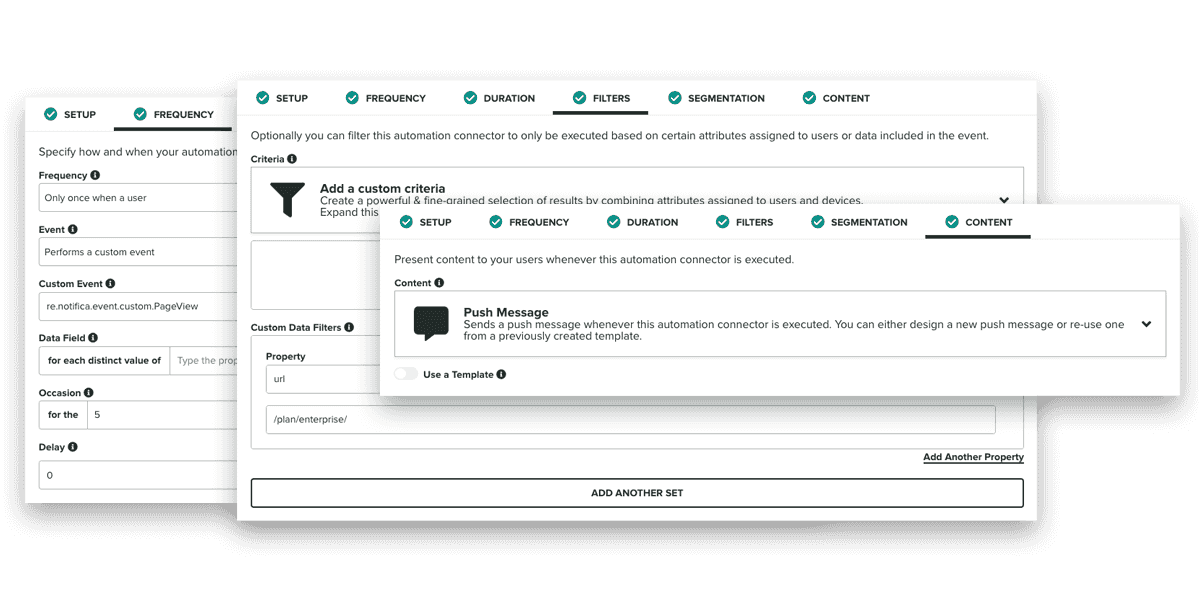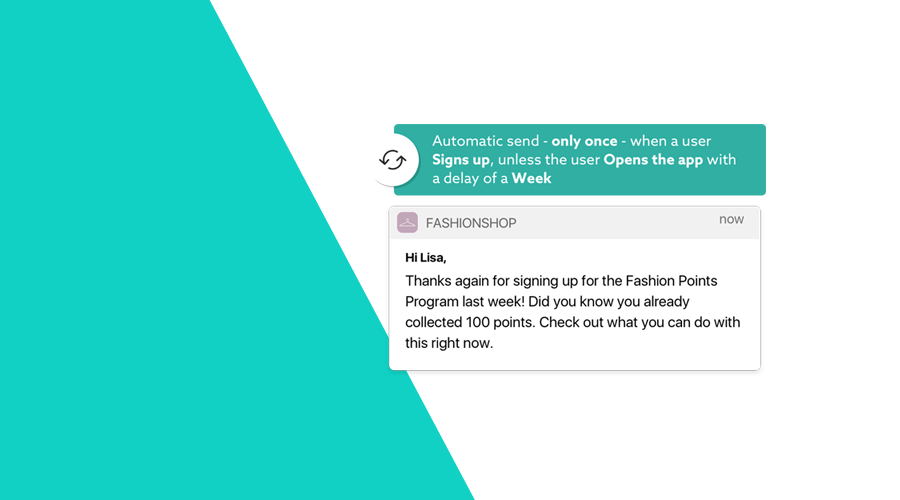As one of our best performing features, our Actionable Analytics is powering organizations of all sizes with event-driven interactions. Its flexible and powerful nature brings so many benefits to the table for both developers and marketers. It completely transforms how organizations design their marketing strategy and develop IT systems.
During 2020, we saw more than a 200% increase in event tracking and in 2021, we expect these interactions to grow even faster. In this post, we will cover the basics, what is in it for you and how to get started. Let us welcome you to event tracking and how you can transform your data into powerful segmentation mechanisms and highly personalized messages.
What is Actionable Analytics
Tracking user's behavior in apps or websites has become an essential part of of what an app or website has to do. Nowadays, companies heavily rely in these insights to improve their processes and evaluate what works and what doesn't. The most popular tools in this field, usually focus on gathering and plotting this data in useful charts. In most cases their job stops there and it's up to marketers to infer knowledge and make business decisions. It's even common and acceptable that all this data will then be harnessed by other tools, at a later stage, to transform this data into tangible marketing campaigns.
With Notificare, companies not only gather these metrics to generate useful charts to help make more informed decisions, but they can also effortlessly transform them into real-time messaging campaigns and user segmentation. By using familiar front-end (from an app or website) or back-end (from a web server) event tracking in conjunction with our powerful marketing automation capabilities, this data can easily be transformed into real-time decisions. This not only provides unparalleled functionality, it also reduces substantially the development time needed to implement transactional messages or highly relevant messaging campaigns.
Nowadays, any modern tailor-made application will have the need to generate this kind of interactions. They usually take the form of account activation email, a two factor authentication SMS, an abandon cart message or an order and shipping status notification. All these types of messages usually take an unnecessary amount of time to develop and once they are done, any change will require developers to adjust it. This is where Actionable Analytics and Automation Connectors can make all the difference.
They can transform an engineer's work into literally one line of code while allowing your marketing team to design, configure its functionality and iterate on the actual content of these messages at any time using a friendly web interface. Possibilities are limitless and can go much further than transactional messages. They are also ideal for personalized messages, like product recommendations or scarcity, loyalty rewards or customer engagement.
Client-side events
But let's take a look at what this actually means for your team. Inside an app or website, event tracking is usually powering how you measure usage or understand your customer's behavior. There are things that only happen in your mobile or web application, like the pages/views they open, buttons they click, etc. These actions are intrinsically linked with customer behavior and will allow you to get personal on that level.
You will then be able to infer knowledge about that behavior and automatically trigger a highly personal message. Let us give you an example, it's very possible that you will be measuring page views in your apps. In Notificare, tracking such things are as easy as implementing this line of code:
notificare.logCustomEvent("PageView", {
url: "/plan/enterprise/"
});Let's now hypothetical consider that you would like to send a message to all users who visit this page for the 5th time with some more information that might convince to make a purchase. This is a very common use case for most companies. In Notificare, you could harness this data by creating an automation connector as follows:

This is just the tip of the iceberg. You can apply this same concept to basically anything that happens in your mobile or web apps. Using these flexible triggering mechanisms and a powerful advanced decision criteria, you can create unique interactions that potentially increase conversions. Additionally, these type of interactions can also be iterated on and/or gradually deployed, first with smaller groups of users and later to a broaden audience, when proven effective. All this is managed via a friendly interface, without any need for changes in your app.
For those of you already using other tools to gather insights and metrics in your app, making the necessary changes for your app to also register those events in Notificare, is not that hard, as explained in this post.
Server-side events
Pretty much the same way, these events can be triggered from a back-end application. In fact, there are use cases where these events can only be done from a server-side application. Let's take for example, shipping status updates. These are generated from some other place, maybe even from a 3rd party API. In order to provide updates via a push, email or SMS messages, you will want to trigger these from your own server. Just like client-side events, these are triggered using a very simple network request, as shown below:
curl --include \
--request POST \
--header "Content-Type: application/json; charset=utf-8" \
--data-binary "{
\"data\": {
\"order_id\": \"2021-123456789\",
\"status\": \"in_transit\"
\"expected_eta\": \"2021-01-01T12:00:00.928+02:00\"
}
}" \
'https://push.notifica.re/event/custom/OrderStatus/U1234567890'Applying this same concept to other events your business cares about, should, by now, seem pretty logical. By combining our Actionable Analytics and Marketing Automation features, you are simply tapping into the best way to gather insights while providing powerful user-centric interactions. All in real-time, without complex IT architectural designs or expensive development sprints.
10 great examples for automated messages
We would like to leave you with some of the most common use cases for event-driven messages. These are just the some of things, organizations of all sizes, are already accomplishing with Notificare.
Account Activation
This type of transactional messages are probably one of the best examples of how actionable analytics and marketing automation can help you iterate and gradually improve your communication. By simply triggering events when users signup, you can then delegate the design of these messages to a marketing team and be always improving one of the most important steps in your customer's journey.Recover Password
Using event-driven messages for this type of communication is another example of how you can gather insights while having all the freedom to gradually improve the its performance.Two-Factor Authentication
Simplifying how you generate these type of messages is one of the best examples of how you can easily tackle this important step in your app's lifecycle by using event-driven messages.User Churn
By using our built-in events (App Open or App Close), you can easily send reminders that generate traffic when users stop visiting your app or website.Product Scarcity
By tracking events when users visit a product page, you can then at any time, use automated messages to increase attention when a product is available in limited supply or it is due to changes in its pricing.Purchase Confirmation
Besides the obvious insights you gather about how your e-commerce application is performing, tracking this type of events will allow you to quickly inform users about their order and how you tackle other important steps in your customer's shopping experience.Shipping Status
Another important type of transactional messages, tracking shipping status changes, will help your brand transform these events into highly important messages that increase transparency, manage expectations and improve a customer's overall experience.Cart Abandonment
In combination with other events, like a purchase confirmation, tracking events when a customer's shopping cart changes can quickly allow you to create automated messages when a purchase is not completed.Micro Surveys
As explained in a previous post, micro surveys can quickly gather feedback from your customers. By triggering these types of messages after a certain amount of visits, a purchase or any other significant interaction with your app or website, you can easily generate an automated micro survey without having to plan it ahead.User Rewards
If you are looking for a solution to automatically reward users after a purchase, an abandoned cart or any other equally important moment in the user's shopping experience, event-driven messages are, by far, the best way to make it all work without any additional development.
Ready to Automate?
Actionable Analytics and Marketing Automation can improve your business processes by simplifying your engineering team's work and providing your marketing team with super powers. If you would like to have a demo, our Sales Team can always assist you or you can always drop a message in our Support Channel if you have any questions.


